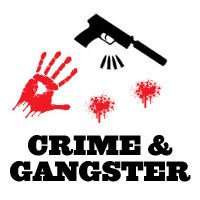 | FILMS Part 1 |
https://www.filmsite.org/crimefilms.html
Part 1 | Part 2 | Part 3 | Examples
See also AFI's 10 Top 10 - The Top 10 Gangster Films Crime stories in this genre often highlight the life of a crime figure or a crime's victim(s). Or they glorify the rise and fall of a particular criminal(s), gang, bank robber, murderer or lawbreakers in personal power struggles or conflict with law and order figures, an underling or competitive colleague, or a rival gang. Headline-grabbing situations, real-life gangsters, or crime reports have often been used in crime films. Gangster/crime films are usually set in large, crowded cities, to provide a view of the secret world of the criminal: dark nightclubs or streets with lurid neon signs, fast cars, piles of cash, sleazy bars, contraband, seedy living quarters or rooming houses. Exotic locales for crimes often add an element of adventure and wealth. Writers dreamed up appropriate gangland jargon for the tales, such as "tommy guns" or "molls." Film gangsters are usually materialistic, street-smart, immoral, meglo-maniacal, and self-destructive. Rivalry with other criminals in gangster warfare is often a significant plot characteristic. Crime plots also include questions such as how the criminal will be apprehended by police, private eyes, special agents or lawful authorities, or mysteries such as who stole the valued object. They rise to power with a tough cruel facade while showing an ambitious desire for success and recognition, but underneath they can express sensitivity and gentleness. Gangster films are often morality tales: Horatio Alger or 'pursuit of the American Dream' success stories turned upside down in which criminals live in an inverted dream world of success and wealth. Often from poor immigrant families, gangster characters often fall prey to crime in the pursuit of wealth, status, and material possessions (clothes and cars), because all other "normal" avenues to the top are unavailable to them. Although they are doomed to failure and inevitable death (usually violent), criminals are sometimes portrayed as the victims of circumstance, because the stories are told from their point of view. Early Crime-Gangster Films Until the Dawn of the Talkies: Criminal/gangster films are one of the most enduring and popular film genres. They date back to the early days of film during the silent era. In fact, even Edwin S. Porter's silent short western The Great Train Robbery (1903) has often considered a classic hold-up story and chase film - a movie about crime. Perhaps the earliest 'crime' film was Sherlock Holmes Baffled (1900), a 45 seconds long short (released in 1903) that was shown one-person at a time in hand-cranked Mutoscope machines or nickelodeons in amusement arcades. It was also the earliest known film featuring Sherlock Holmes. The plot was about how the famed Arthur Conan Doyle detective, a cigar-smoking gentleman, was 'baffled' when a black-clothed thief magically disappeared (through trick-photography) with a sack of stolen goods. Also, The Adventures of Sherlock Holmes (1905), released by Vitagraph (although now a lost film) has been considered the first Sherlock Holmes film since it was created for a theatrical audience rather than as a one-person Mutoscope production. One of the first films to officially mark the start of the gangster/crime genre was D. W. Griffith's The Musketeers of Pig Alley (1912) about organized crime. It wasn't the first gangster movie ever made, but it was the first significant gangster film that has survived. Outdoor scenes were shot in the gangland territory of NYC's Lower East Side with its slum tenements, and cast members included possible gang members. The story was about a poor, virtuous, and vulnerable Little Lady (Lillian Gish) who was threatened, victimized and terrorized by Snapper Kid (Elmer Booth) - the gangster leader of a gang known as the Musketeers. [Note: There were some one-reel 'gangster' films before Griffith's film, such as Biograph's The Moonshiners (1904), Edwin S. Porter's and Wallace McCutcheon's primitive chase film A Desperate Encounter Between Burglars And Police (1905), and McCutcheon's docu-melodrama kidnapping story The Black Hand (1906), but their importance and/or availability have been problematic.]French director Louis Feuillade's Fantomas series from the Gaumont film studio popularized the crime serial - Fantomas (1913-1914, Fr.) featured the character of supercriminal Fantomas (René Navarre). Based on the novels of Marcel Allain and Pierre Souvestre, Fantomas was released as five separate films, running roughly an hour each. Other characters included police inspector Juve (Edmund Breon) and newspaper journalist Fandor (Georges Melchior), who worked to bring down the arch-villain-thief (a master of disguises), who also committed identity theft and murder. The five episodes were:
Traffic in Souls (1913) (aka While New York Sleeps), a six-reel melodrama, was a "photo-drama" expose of white slavery (entrapment of young women into prostitution) at the turn of the century in NYC, although the film exploitatively promised steamy sex in its advertisements. Mutual released The Gangsters and the Girl (1914), a short starring Charles Ray as undercover Detective John Stone investigating neighborhood urban gangs and a wrongly-condemned slum girl. 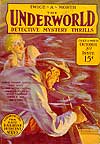 Raoul Walsh's first feature film, the silent crime drama The Regeneration (1915) has been regarded as the first feature-length gangster film, with presumably the first complex characterization of a criminal anti-hero. It showcased violent lawlessness on the streets of New York (it was shot on location in NYC's Bowery District on the Lower East Side), and the rise of an orphaned Irish-American slum boy named Owen Conway (Rockliffe Fellowes as a 25 year-old adult). He grew up to become a drunken gangster (prone to gambling) due to repressive social conditions in his environment. However, he was 'regenerated' (saved from a life of crime) after falling in love with do-gooder social worker Marie Deering (Anna Q. Nilsson). Raoul Walsh's first feature film, the silent crime drama The Regeneration (1915) has been regarded as the first feature-length gangster film, with presumably the first complex characterization of a criminal anti-hero. It showcased violent lawlessness on the streets of New York (it was shot on location in NYC's Bowery District on the Lower East Side), and the rise of an orphaned Irish-American slum boy named Owen Conway (Rockliffe Fellowes as a 25 year-old adult). He grew up to become a drunken gangster (prone to gambling) due to repressive social conditions in his environment. However, he was 'regenerated' (saved from a life of crime) after falling in love with do-gooder social worker Marie Deering (Anna Q. Nilsson).The upcoming 1920s decade was a perfect era for the blossoming of the crime genre. It was the period of Prohibition, grimy and overpopulated cities with the lawless spread of speakeasies, corruption, and moonshiners, and the flourishing rise of organized gangster crime. Josef von Sternberg's gangland melodrama Underworld (1927) with George Bancroft and Clive Brook, reflected the 1920s. It has often been considered the first modern gangster film, with many standard conventions of the crime film - and it was shot from the gangster's point of view. It won the Best Original Story Award for Ben Hecht - the first Oscar ever awarded for an original screenplay, and the first of Hecht's two Oscar wins (among six writing nominations during his career). [The first 'gangster' pulp had the same title, Underworld, a breeding ground for many crime thriller plots.] And Lewis Milestone's The Racket (1928), a Howard Hughes-produced film, concentrated on big-city corruption and a municipality controlled by the mob, and was banned in Chicago because of its negative depiction of the police. Expressionistic German Crime Films: Three German directors contributed a number of expressionistic black and white crime films, noted for chiaroscoro lighting, sharp-angled shots, and monstrous characters (i.e., insane scientists or doctors, or crazed individuals):
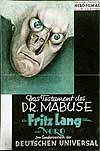 F.W. Murnau's silent classic Sunrise (1927), was about a country village farmer (George O'Brien) who fell for the allure of a sophisticated, vampish seductress/temptress (Margaret Livingston) from the City. She tempted him under the moonlight in a swamp, persuading him to devise a murderous plan to kill his pure, innocent wife (Janet Gaynor) - by drowning her during a trip to the City. F.W. Murnau's silent classic Sunrise (1927), was about a country village farmer (George O'Brien) who fell for the allure of a sophisticated, vampish seductress/temptress (Margaret Livingston) from the City. She tempted him under the moonlight in a swamp, persuading him to devise a murderous plan to kill his pure, innocent wife (Janet Gaynor) - by drowning her during a trip to the City.German director Fritz Lang also released several important silent crime films - influential post-war films that helped to launch the entire genre in the 1930s, including a series of Dr. Mabuse films about a mastermind character:
The Gangster Film in the Era of the "Talking Picture": It wasn't until the sound era and the 1930s that gangster films truly became an entertaining, popular way to attract viewers to the theatres, who were interested in the lawlessness and violence on-screen. The events of the Prohibition Era (until 1933) such as bootlegging and the St. Valentine's Day Massacre of 1929, the existence of real-life gangsters (e.g., Al Capone, John Dillinger, "Pretty Boy" Floyd, "Baby Face" Nelson) and the rise of contemporary organized crime and escalation of urban violence helped to encourage this genre. On the other side were law-enforcing "G-Men" (or "government men") led by the FBI's J. Edgar Hoover. Many of the sensationalist plots of the early gangster films were taken from the day's newspaper headlines, encouraging the public appetite for crime films. The allied rackets of bootlegging, gambling and prostitution brought these mobsters to folk hero status, and audiences during that time vicariously participated in the gangster's rise to power and wealth - on the big screen. They vicariously experienced the gangster's satisfaction with flaunting the system and feeling the thrill of violence. Movies flaunted the archetypal exploits of swaggering, cruel, wily, tough, and law-defying bootleggers and urban gangsters. The talkies era accounted for the rise of crime films, because these films couldn't come to life without sound (machine gun fire, screeching brakes, screams, chases through city streets and squealing car tires). The perfection of sound technology and mobile cameras also aided their spread. The first "100% all-talking" picture and, of course, the first sound gangster film was The Lights of New York (1928) - it enhanced the urban crime dramas of the time with crackling dialogue and exciting sound effects of squealing getaway car tires and gunshots. Rouben Mamoulian's City Streets (1931) from a story penned by Dashiell Hammett was reportedly Al Capone's favorite film, starring Gary Cooper and Sylvia Sydney as two lovers trapped by gangland connections. And Tay Garnett's violent Bad Company (1931) was the first picture to feature the gangland massacre on St. Valentine's Day. Three Classic Early Gangster Films from Warner Bros: 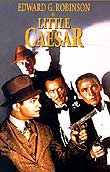 Warner Bros. was considered the gangster studio par excellence, and the star- triumvirate of Warners' gangster cycle, all actors who established and defined their careers as tough-guys in this genre, included Edward G. Robinson, James Cagney, and Humphrey Bogart. Others who were early gangster stars included Paul Muni and George Raft. Warner Bros. was considered the gangster studio par excellence, and the star- triumvirate of Warners' gangster cycle, all actors who established and defined their careers as tough-guys in this genre, included Edward G. Robinson, James Cagney, and Humphrey Bogart. Others who were early gangster stars included Paul Muni and George Raft.Three great classic gangster films (among the first of the talkies) marked the genre's popular acceptance and started the wave of gangster films in the 1930s in the sound era. The lead role in each film (a gangster/criminal or bootleg racketeer of the Prohibition Era) was glorified as he rose to the top with infamy and power, but each one ultimately met his doom in the final violent scenes of these films, due to censors' demands that they receive moral retribution for their crimes. The first two films in the cycle were released almost simultaneously by Warner Bros, setting the pattern for numerous imitators (with tommy guns, fedoras, double-breasted suits, etc.): (1) Little Caesar (1930), directed by Mervyn LeRoy, starred Edward G. Robinson as a gritty, coarse and ruthless, petty Chicago killer named Caesar Enrico (or "Rico") Bandello (a flimsy disguise for a characterization of Al Capone), who experienced a rise to prominence and then a rapid downfall. Robinson was the first great gangster star.(2) The Public Enemy (1931), directed by William Wellman, starred James Cagney (in his first film and breakout role) as a cocky, fast-talking, nasty, and brutal criminal/bootlegger named Tom Powers - most memorable in a vicious scene at the breakfast table where the snarling gangster assaulted his floozy moll girlfriend (Mae Clarke) by pressing a half grapefruit into her face. [Both were still in their pajamas, indicating that they spent the night together.] The startling finale included the door-to-door delivery of Cagney's mummy-wrapped corpse to his mother's house - the bandaged body fell through the front door. The main story was about two brothers, Tom (Cagney) and his straight, uptight brother Mike (Donald Cook) who grew up and pursued very different lifestyles. The pre-Code film emphasized how the early developmental environment clearly contributed to an evolving life of adult crime - and his inevitable gruesome death.Both The Public Enemy (1931) and Scarface (1932) tried to deflect criticisms that they were sensationalizing the lifestyle of the hoodlums, with unconvincing prefaces or disclaimers. In particular, Scarface (1932) began with a critical, written statement to indict gangster hoodlumism and the public's and government's indifference. The audience was then blamed for promoting the role of the gangster with its perverse fascination in the phenomenon of mob activity - and then challenged:
The coming of the Hays Production Code in the early 1930s spelled the end to glorifying the criminal, and approval of the ruthless methods and accompanying violence of the gangster lifestyle. The censorship codes of the day in the 1930s, notably the Hays Office, forced studios (particularly after 1934) to make moral pronouncements, present criminals as psychopaths, end the depiction of the gangster as a folk or 'tragic hero,' de-glorify crime, and emphasize that crime didn't pay. It also demanded minimal details shown during brutal crimes.  One way the studios quieted some of the protest and uproar over "America's shame" was to shift the emphasis from the criminal to the racket-busting federal agents, private detectives, or "good guys" on the other side of the law. In William Keighley's G-Men (1935), the best example of this new 'gangster-as-cop' sub-genre, screen tough guy James Cagney starred as a ruthless, revenge-seeking, impulsive, violent FBI agent to infiltrate criminal gangs on a crime spree in the Midwest. Although he was on the side of the law working undercover, he was just as cynical, brutal, and arrogant as he had been in his earliest gangster films. One way the studios quieted some of the protest and uproar over "America's shame" was to shift the emphasis from the criminal to the racket-busting federal agents, private detectives, or "good guys" on the other side of the law. In William Keighley's G-Men (1935), the best example of this new 'gangster-as-cop' sub-genre, screen tough guy James Cagney starred as a ruthless, revenge-seeking, impulsive, violent FBI agent to infiltrate criminal gangs on a crime spree in the Midwest. Although he was on the side of the law working undercover, he was just as cynical, brutal, and arrogant as he had been in his earliest gangster films.A police detective (Edward G. Robinson in an against-type role) went undercover and joined a NYC racket in Bullets or Ballots (1936), and in Anatole Litvak's The Amazing Dr. Clitterhouse (1938), Robinson portrayed a brainy crime specialist who joined Rocks Valentine's gang (led by Humphrey Bogart) and soon was masterminding heists. Robinson also starred as a college law professor - and special prosecutor who pursued justice in I Am the Law (1938). Anthony Mann's T-Men (1947) explored the similarities between Treasury Department agents and the counterfeiting criminals they pursued, and emphasized how villains were caught by semi-documentary style crime detection procedures (lineups, fingerprinting analysis, lab work, etc.). 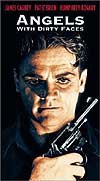 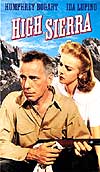 Another developing 'Cain-and-Abel' sub-genre emphasized that crime didn't pay, in films such as Manhattan Melodrama (1934) with childhood friends William Powell and Clark Gable choosing two diametrically opposed lifestyles - prosecuting attorney and gambler/racketeer, and Angels With Dirty Faces (1938) with two young slum kids, James Cagney and Pat O'Brien, following two different paths - a criminal lifestyle (that was idolized by the Dead End Kids on New York's lower East Side) and the priesthood. In the electrifying finale, Cagney was taken on a long walk to his execution. Another developing 'Cain-and-Abel' sub-genre emphasized that crime didn't pay, in films such as Manhattan Melodrama (1934) with childhood friends William Powell and Clark Gable choosing two diametrically opposed lifestyles - prosecuting attorney and gambler/racketeer, and Angels With Dirty Faces (1938) with two young slum kids, James Cagney and Pat O'Brien, following two different paths - a criminal lifestyle (that was idolized by the Dead End Kids on New York's lower East Side) and the priesthood. In the electrifying finale, Cagney was taken on a long walk to his execution.William Wyler's gangster melodrama Dead End (1937) portrayed the efforts of New York slum dweller (Sylvia Sidney) to keep her gang member brother Tommy (Billy Halop, one of the Dead End Kids) from emulating gangster Humphrey Bogart. The adolescent gang actors (veterans of the Broadway version of Dead End) were introduced in this film and later evolved into the East Side Kids and The Bowery Boys. |
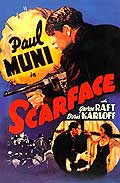 (3)
(3)